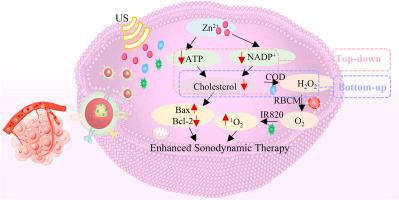“自上而下和自下而上”的胆固醇消耗仿生纳米颗粒增强对肝细胞癌的声动力治疗
IF 10.2
1区 医学
Q1 ENGINEERING, BIOMEDICAL
引用次数: 0
摘要
肿瘤细胞中的胆固醇消耗已被证明是一种有效的癌症治疗策略。先前的研究表明,胆固醇氧化酶(COD)可以促进胆固醇的消耗。然而,这些肿瘤细胞通常上调胆固醇合成作为一种补偿机制,以满足快速增殖的需求。为了解决这一问题,我们合成了HM/ZIF-8@COD/IR820纳米颗粒,该纳米颗粒同时促进胆固醇消耗和抑制胆固醇合成,以增强对肝细胞癌(HCC)的声动力治疗。将胆固醇氧化酶(COD)和声敏剂吲哚菁绿(IR820)包埋在ZIF-8纳米颗粒中,再包覆肿瘤细胞和红细胞膜杂交膜,构建了HM/ZIF-8@COD/IR820仿生纳米颗粒。杂交膜具有肿瘤靶向能力,使HM/ZIF-8@COD/IR820纳米颗粒能够附着在Hepa1-6肿瘤上,并在酸性微环境和超声刺激下分解。体外和体内研究证实了Hepa1-6细胞显著的胆固醇消耗和缺氧缓解。超声激活后,产生大量活性氧(ROS),从而增强了对接种肿瘤的治疗效果。非靶向代谢组学分析进一步验证了胆固醇代谢相关通路的下调,这与细胞实验中观察到的Filipin染色结果一致。重要的是,Hepa1-6的肿瘤生长明显受到抑制,抑制率达到90%。这些发现强调了HM/ZIF-8@COD/IR820作为一种有前途的仿生纳米颗粒,可以对肝细胞癌胆固醇代谢进行双管齐下的攻击:自上而下抑制胆固醇生物合成途径,自下而上消除现有的胆固醇储存,对HCC产生显著的治疗效果。本文章由计算机程序翻译,如有差异,请以英文原文为准。

“Top-down and Bottom-up” cholesterol-depleting biomimetic nanoparticle for enhancing sonodynamic therapy against hepatocellular carcinoma
Cholesterol depletion in tumor cells has been demonstrated as an effective strategy for cancer therapy. Previous studies have shown that cholesterol oxidase (COD) could promote cholesterol consumption. However, these tumor cells typically upregulate cholesterol synthesis as a compensatory mechanism to meet the rapid proliferation demands. To address this issue, we synthesized HM/ZIF-8@COD/IR820 nanoparticle, which simultaneously facilitates cholesterol depletion and inhibits cholesterol synthesis to enhance sonodynamic therapy against hepatocellular carcinoma (HCC). This HM/ZIF-8@COD/IR820 biomimetic nanoparticle was constructed by encapsulating cholesterol oxidase (COD) and the sonosensitizer indocyanine green (IR820) into ZIF-8 nanoparticle, followed by coating with a hybrid cell membrane from tumor cells and erythrocyte membrane. The hybrid membrane provides tumor-targeting capability, enabling HM/ZIF-8@COD/IR820 nanoparticle homes to Hepa1-6 tumor and disassembles in response to the acidic microenvironment and ultrasound stimulation. In vitro and in vivo studies confirmed significant cholesterol depletion and alleviation of hypoxia in Hepa1-6 cells. Upon ultrasound activation, a significant amount of reactive oxygen species (ROS) was generated, thereby enhancing the therapeutic effect on the inoculated tumors. Non-targeted metabolomics analysis further validated the downregulation of cholesterol metabolism-related pathways, which was consistent with the Filipin staining results observed in cellular experiments. Importantly, Hepa1-6 tumor growth was significantly suppressed and the inhibition rate reached 90%. These findings highlight HM/ZIF-8@COD/IR820 as a promising biomimetic nanoparticle orchestrates a two-pronged attack on hepatocellular carcinoma cholesterol metabolism: top-down suppression of cholesterol biosynthetic pathways, and bottom-up elimination of existing cholesterol stores, yielding outstanding therapeutic effects against HCC.
求助全文
通过发布文献求助,成功后即可免费获取论文全文。
去求助
来源期刊

Materials Today Bio
Multiple-
CiteScore
8.30
自引率
4.90%
发文量
303
审稿时长
30 days
期刊介绍:
Materials Today Bio is a multidisciplinary journal that specializes in the intersection between biology and materials science, chemistry, physics, engineering, and medicine. It covers various aspects such as the design and assembly of new structures, their interaction with biological systems, functionalization, bioimaging, therapies, and diagnostics in healthcare. The journal aims to showcase the most significant advancements and discoveries in this field. As part of the Materials Today family, Materials Today Bio provides rigorous peer review, quick decision-making, and high visibility for authors. It is indexed in Scopus, PubMed Central, Emerging Sources, Citation Index (ESCI), and Directory of Open Access Journals (DOAJ).
 求助内容:
求助内容: 应助结果提醒方式:
应助结果提醒方式:


